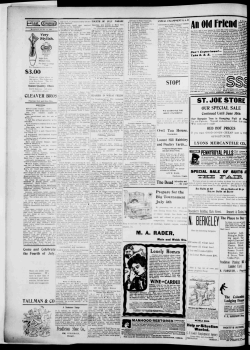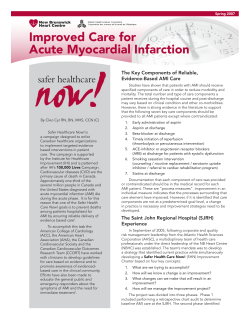
ECG Patterns That Confound the Diagnosis of AMI Diagnosis of Myocardial Infarction History
10/31/2011 ECG Patterns That Confound the Diagnosis of AMI Diagnosis of Myocardial Infarction • History William Brady, MD Professor • Examination Department of Emergency Medicine University of Virginia & Operational Medical Director • ECG Charlottesville‐Albemarle Rescue Squad Albemarle County Fire Rescue Madison County EMS Special Event Medical Management • Biomarkers Seminole Trail Fire Department Earlysville Volunteer Fire Department ECG Limitations EMS Multiple causes of ST segment elevation ‐‐ Adult patients ‐‐ Chest pain (or equivalent) ‐‐ ST elevation in 2 leads ED • • • • Non‐diagnostic ECG Evolving event Confounding patterns Confounding patterns Anatomical issues ….Same criteria for fibrinolysis & PCI 1 10/31/2011 Diagnosis of Myocardial Infarction Confounding ECG Patterns • History • Examination X • ECG • History • Examination • Biomarkers The ECG Cycle Electrocardiographic Diagnosis of ACS Much information is contained in ECG regarding g g ACS High-yield portions of ECG -- ST segment & T wave • Biomarkers ST Segment & T Wave ST Segment & T Wave (& QRS Complex) 2 10/31/2011 ST Segment & T Wave (& QRS Complex) QUESTION: Why is the QRS complex Important when considering the ST segment? ANSWER: If BBB, paced rhythm, or LVH pattern is present, interpretation of ST segment / T wave will be altered. ECG ST Elevation BBB / LVH / Paced Normal Intraventricular Conduction Appropriate Discordance ST Segment / T Wave LBBB Normal LVH Left Bundle Branch Block Paced 3 10/31/2011 Left Bundle Branch Block • LBBB reduces diagnostic power of ECG • Changes mask ischemic change – or can be misinterpreted as injury/infarct • Most frequently misinterpreted pseudoinfarct pattern in practice today, responsible for: – Delayed diagnosis & RX of AMI Left Bundle Branch Block • Patients with LBBB pattern: – If new • Candidates for thrombolysis • At high risk for CHB, cardiogenic shock, & death h k &d h – If old • Have significant, pre‐existing LV dysfunction • High risk for death • May benefit significantly from acute revascularization therapies – More so than “typical” AMI patients • Yet are diagnosed early much less often Left Bundle Branch Block • Characteristics Left Bundle Branch Block Normal ST Segment & T Wave – QRS complex > 0.12 sec – Mainly negative QS or rS complex in lead V1 – Monophasic R wave in leads V6, I & aVl • Secondary repolarization findings: y p g – QS or rS complexes ‐‐ ST elevation – Large monophasic R wave ‐‐ ST depression • Explained by the Concept of Appropriate Discordance ‐‐ ST segment / T wave complex is directed opposite from the major, terminal portion of the QRS complex 4 10/31/2011 Appropriate Discordance “Normal” ST Segment & T Wave Configurations in LBBB Abnormal Findings in LBBB “Sgarbossa’s Criteria” ST Segment & T Wave Configurations Suggestive of AMI in LBBB Sgarbossa’s Criteria Clinical Decision Tool Concordant ST Segment Depression (in leads V1, V2, or V3) “Excessive” Discordant ST Segment Elevation ( > 5 mm ) Concordant ST Segment Elevation ( > 1 mm ) NEJM 1996;334:481 NEJM 1996;334:481 5 10/31/2011 Concordant ST Segment Elevation Strongly Suggestive of AMI LBBB with AMI Concordant ST Segment Elevation LBBB with AMI LBBB with AMI Concordant ST Segment Elevation Concordant ST Segment Elevation 6 10/31/2011 LBBB with AMI Concordant ST Segment Elevation Concordant ST Segment Depression (Limited to Leads V1, V2, or V3) Strongly Suggestive of AMI LBBB with AMI LBBB with AMI Concordant ST Segment Depression Concordant ST Segment Depression 7 10/31/2011 LBBB with AMI LBBB with AMI Concordant ST Segment Depression Concordant ST Segment Depression LBBB with AMI LBBB with AMI Concordant ST Segment Depression Concordant ST Segment Depression 8 10/31/2011 “Excessive” Discordant ST Segment Elevation (> 5 mm) Somewhat Strongly Suggestive of AMI LBBB with AMI Excessive Discordant ST Segment Elevation > 5 mm LBBB with AMI LBBB with AMI Excessive Discordant ST Segment Elevation Excessive Discordant ST Segment Elevation 9 10/31/2011 LBBB with AMI LBBB with AMI Excessive Discordant ST Segment Elevation Excessive Discordant ST Segment Elevation LBBB with AMI “Excessive” Discordance or Proportional ST Segment Elevation? Excessive Discordant ST Segment Elevation > 5 mm 10 10/31/2011 “Excessive” Discordant ST Segment Elevation (> 5 mm) Excessive Discordant ST Segment Elevation Somewhat Strongly Suggestive of AMI NOT INDICATIVE OF ELECTROCARDIOGRAPHIC AMI ST Segment Elevation is Proportional to Size of QRS Complex > 5 mm NORMAL Concordant ST Segment Elevation ( > 1 mm ) ABNROMAL Concordant ST Segment Depression (in leads V1, V2, or V3) EQUIVOCAL Proportional Discordant ST Segment Elevation ( > 5 mm ) Serial ECGs: 1 of 2 Serial ECGs: 2 of 2 Evolution of AMI with LBBB “Concerning” Chest Pain Presentation 1443 1501 11 10/31/2011 Serial ECGs: 2 of 2 Evolution of AMI with LBBB 1501 Ventricular Paced Rhythm • Elderly population w/ pre-existing heart disease • ECG characteristics Ventricular P Paced d Rh Rhythm th Ventricular Paced Rhythm Normal Findings – Broad, mainly negative QS complexes l (l(leads d V1 to t V6) – QS complexes may also seen in leads II, III & aVf – Large monophasic R wave -leads I & aVL 12 10/31/2011 Ventricular Paced Pattern Normal ST Segment & T Wave “Sgarbossa’s Criteria” ST Segment & T Wave Configurations Suggestive of AMI with Ventricular Paced Rhythms Concordant ST Segment Depression (in leads V1, V2, or V3) “Excessive” Discordant ST Segment Elevation ( > 5 mm ) Concordant ST Segment Elevation ( > 1 mm ) Ventricular Paced Pattern with AMI Concordant ST Segment Elevation Ventricular Paced Pattern Ventricular Paced Pattern with AMI Concordant ST Segment Elevation Ventricular Paced Pattern 13 10/31/2011 Serial ECGs: 1 of 2 Serial ECGs: 1 of 2 Ventricular Paced Pattern with Chest Pain Ventricular Paced Pattern with Chest Pain Excessive Discordant ST Segment Elevation 0359 0422 Serial ECGs: 1 of 2 Ventricular Paced Pattern with Chest Pain Excessive Discordant ST Segment Elevation 0422 Left Ventricular Hypertrophy yp p y Pattern 14 10/31/2011 Left Ventricular Hypertrophy with Strain Pattern • LVH pattern reduces diagnostic power of ECG • Like LBBB, changes mask & mimic ACS‐related findings • LVH by voltage criteria LVH by voltage criteria – Many – S (Q) wave V1 + R wave V6 > 35 mm • “Strain” pattern – ST segment & T wave changes – Seen in 75% of LVH pattern presentations LVH with Strain Pattern • LVH seen frequently in adult chest pain patients suspected of ACS • Final hospital Dx – 26% ultimately ACS – 74% non‐ACS • ECG incorrectly interpreted > 70% of cases – Frequently did not identify LVH pattern – Attributed ST / T changes to ischemia or infarction – Observed changes resulted from • Stress importance of correct ECG interpretation – Directly impacts therapeutic & diagnostic decisions Larsen et al, J Gen Intern Med 1994 QRS Complex Size? The LVH Pattern QRS Complex Size? Determination of QRS Complex Size V1 / V2 V5 / V6 + * 35 > 35 mm Q wave R Wave *In a patient > age 35 years 15 10/31/2011 QRS Complex Size? • • • • ST segment & T wave changes in LVH 80% of patients with this ECG pattern Not indicative of ACS Mimic & mask ACS LVH with Strain Pattern V2 V3 V6 aVL ST Segment Depression & T Wave Inversion ST Segment Elevation Left Ventricular Hypertrophy Left Ventricular Hypertrophy with Strain Pattern 16 10/31/2011 Left Ventricular Hypertrophy with Strain Pattern Left Ventricular Hypertrophy with Strain Pattern Left Ventricular Hypertrophy with Strain Pattern Evolving AMI Left Ventricular Hypertrophy with Strain Pattern Evolving AMI 17 10/31/2011 Left Ventricular Hypertrophy with Strain Pattern Evolving AMI Right Bundle Branch Block Left Ventricular Hypertrophy with Strain Pattern Evolving AMI Right Bundle Branch Block • Does not obscure ECG DX of AMI • May confuse ECG Dx of ACS • Lack of knowledge of anticipated ST segment & T wave patterns – “Hide” ACS – Incorrectly “suggest” ACS 18 10/31/2011 • May also hinder ECG diagnosis – Not due to electrophysiologic issues – Resulting from interpretative errors • Age of RBBB – Chronicity not an issue for fibrinolysis not an issue for fibrinolysis – ECG can be interpreted – consider ST segments – Marker for poor outcome • NRMI‐2 registry – RBBB pattern in approximately 6% of AMI patients – Less often received fibrinolysis – Increased poor outcome [64% increased odds ratio of death] • Worse than LBBB! Right Bundle Branch Block Right Bundle Branch Block • Characteristics of RBBB – QRS complex > 0.12 sec – Broad, monophasic R or RSR’ wave in lead V1 – Wide S or RS wave in lead V6 • Marked ST segment changes are seen – Right precordial leads -- ST depression – Inferior & left precordial leads -- upright T wave & ST elevation 19 10/31/2011 RBBB with Anterior Wall STEMI RBBB with Anterior Wall STEMI V4 0037 V4 0037 V4 0129 0129 RBBB with Anterior Wall STEMI RBBB with Anterior Wall STEMI 20 10/31/2011 Case History (for all cases today) Cases Case #1 • 58 year‐old male / female • Chest pain • Dyspnea with diaphoresis • Exam – anxious & diaphoretic • ECG……….. Case #2 21 10/31/2011 Case #3 Case #4 Case #5 Case #6 22 10/31/2011 Case #7 Case #8 Case #9 Case #10 23 10/31/2011 Case #11 Case #12 Case #13 24
© Copyright 2025












